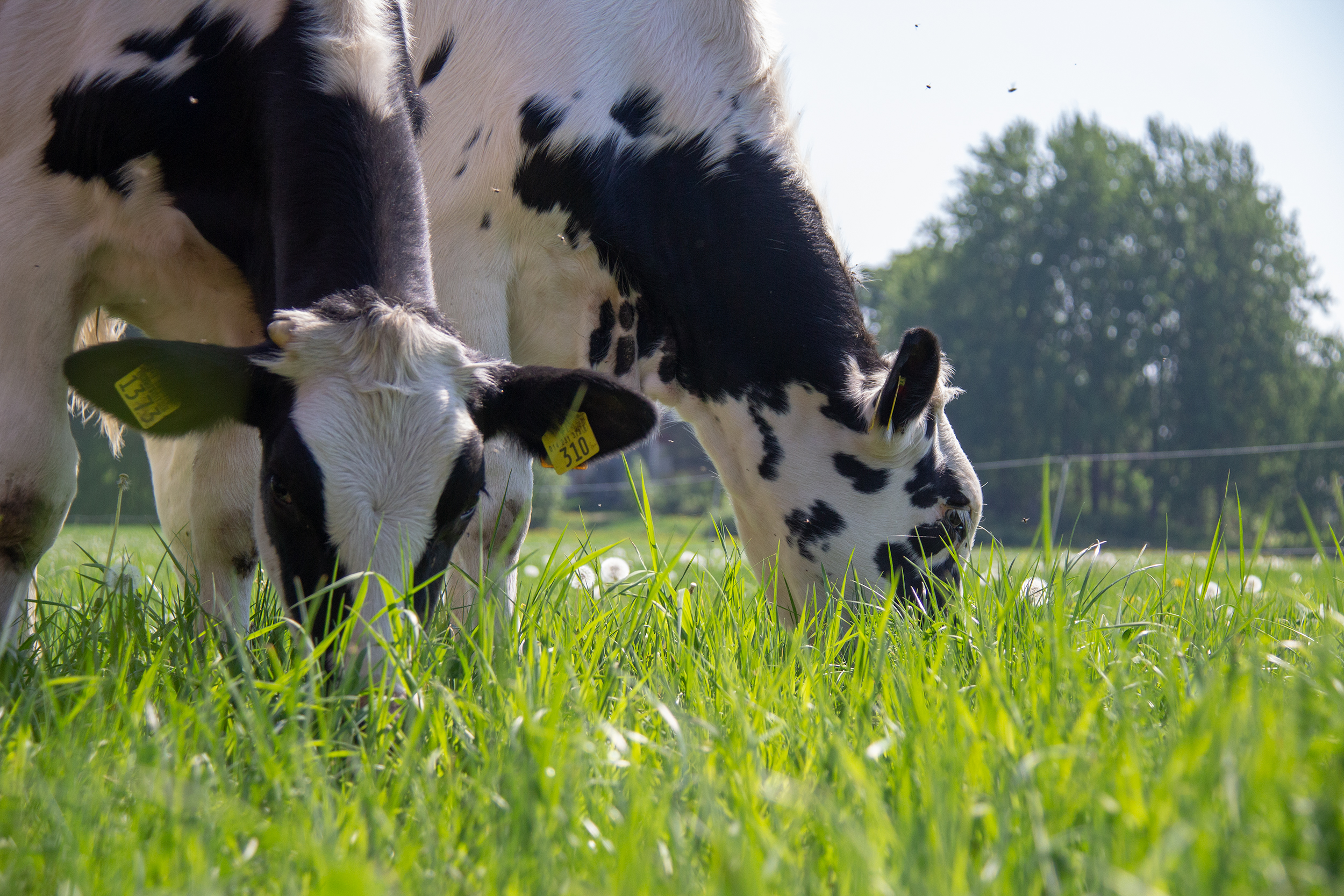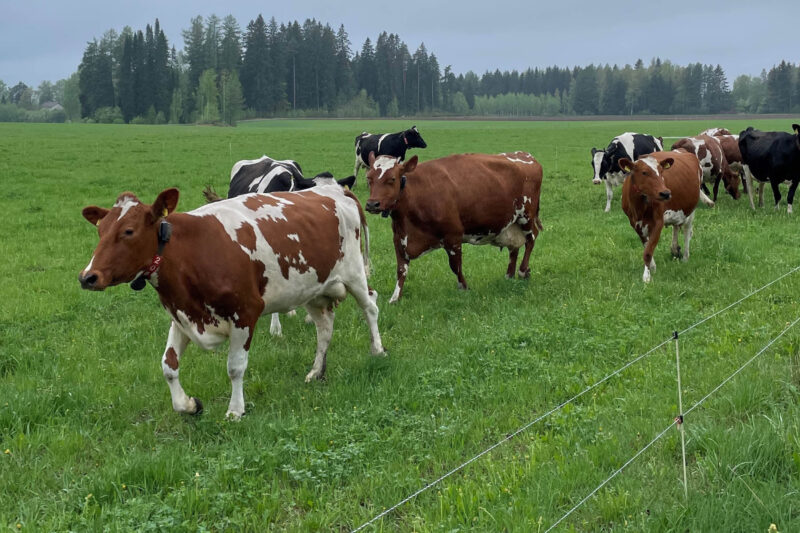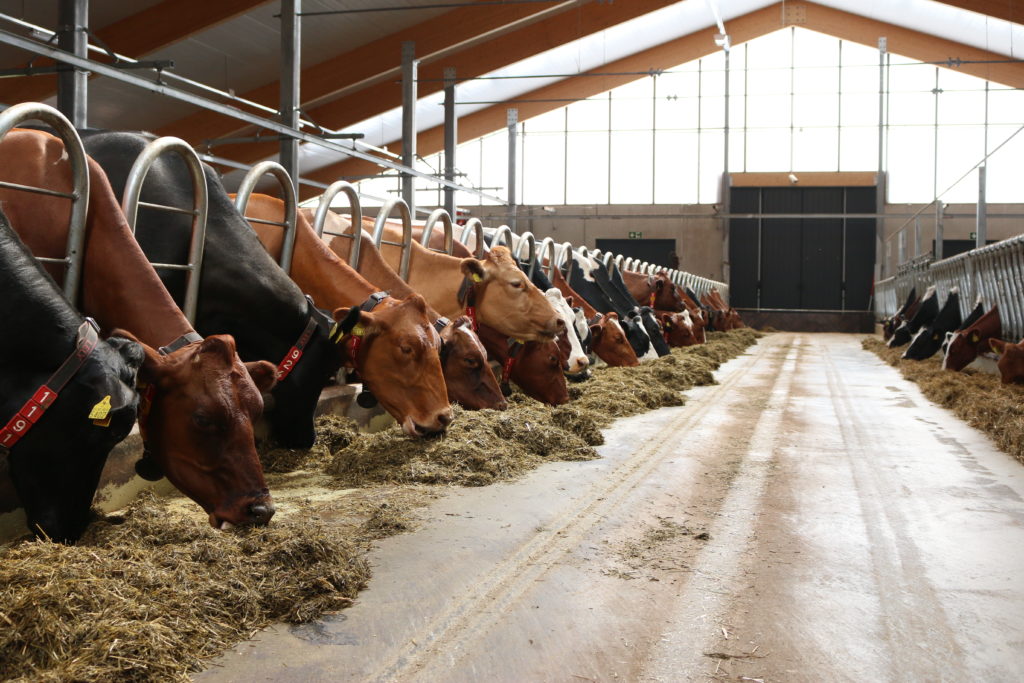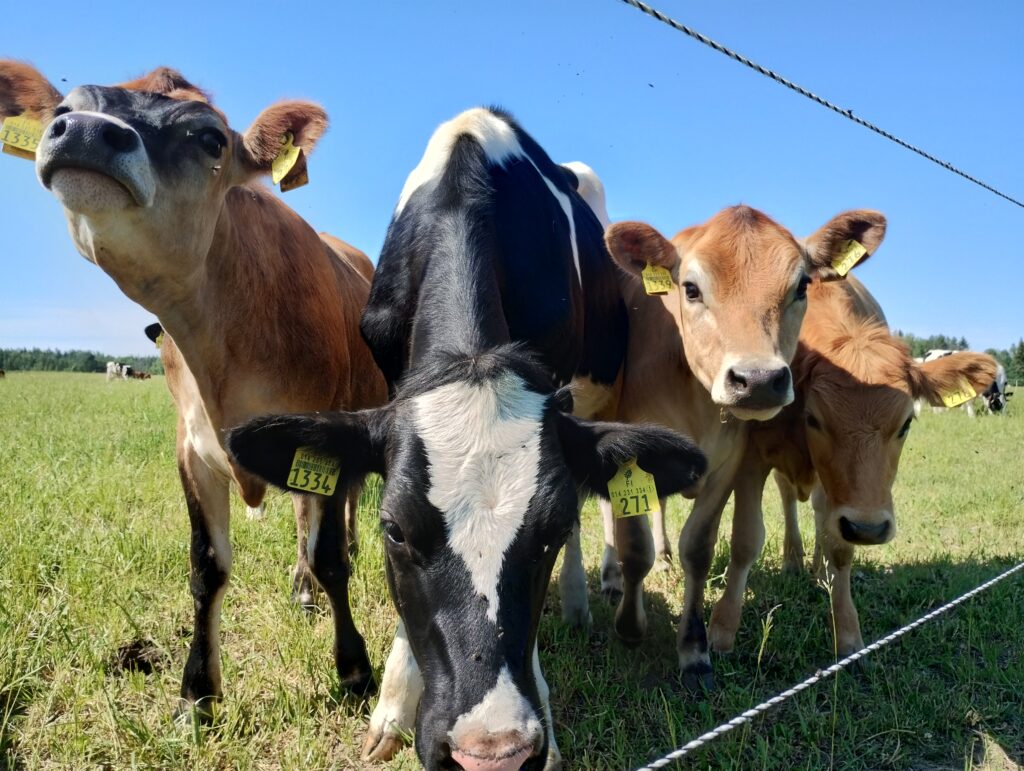
Livestock production
Mustiala teaching and research farm specializes in milk production. The herd of about 75 cows consists of a wide variety of breeds.
Mustiala cattle
Mustiala teaching and research farm specializes in dairy production. The herd of about 75 cows consists of a wide variety of breeds. All dairy-producing breeds in Finland can be found at Mustiala. The main focus is on the dominant breeds Ayrshire and Holstein, but in addition, there are representatives of all Finnish cattle breeds, including Jerseys and Brown Swiss. The Finnish cattle herd was strengthened in the spring of 2021 when well-bred ISK and LSK calves and heifers were purchased. In addition, the calf herd includes crossbred calves for meat production, which are sold to continue their growth on other farms. All bull calves are sold for meat, as well as crossbred heifer calves.
Information about livestock production is obtained from many different sources. The Valma system from Valio provides information on the concentrations and quality of milk batches sent to the dairy every other day. In addition, the dairy conducts feed analyses based on the samples sent. The Valma system can also be used to calculate the carbon footprint of milk. The milking robot provides a lot of information on both the herd and individual cows, such as daily milk yields, how many times a cow visits the milking robot, and the concentrations of milk. Continuous monitoring of electrical conductivity and somatic cell count, which measure udder health, is also important in the production of E-class milk.
In connection with the milking, an industrial concentrate feed mixture is provided. Feeding is based on a feeding plan, which is updated whenever the feeds change. Cows in automatic milking receive other feeds as partial mixed ration (PMR), which includes all feeds produced at Mustiala. Other animal groups are fed as total mixed ration (TMR). Feeding is completely automated with the Lely Vector feeding system.
The Mustiala herd has been included in production monitoring since July 1, 1935. The information produced by production monitoring, health monitoring, evaluation of all cows’ conformation, and genomic testing of cow calves provide a solid foundation for the development of the herd. The productive and diverse organic cattle of Mustiala is indeed a beautiful sight to behold.
The feeding of the cattle has been changed towards organic grass-based feed, which means that the proportion of concentrate feed in the feeding should be at most 40% of the total dry matter. This applies to animals over 6 months of age. In feed production, the aim is to achieve as high self-sufficiency in feed as possible. At Mustiala, grass is produced for silage and pasture. Domestic barley and oats are fed as cereal concentrate. The protein content of the home-mixed feed, which is produced by a feed mill, is increased with peas or faba beans. In the summer of 2021, maize was also included, for which there was already experience from the summer of 2019. The aim was to conduct a feeding experiment with maize silage as part of a thesis during the indoor feeding season 2021-2022.
All feeds are analyzed. Samples are taken from the silage silos several times to monitor possible changes in feed values and dry matter content. The feeding plan is always updated when feeds or feed values change. The planning tool used is ProAgria’s Livestock Compass.
In practice, feeding is done through total mixed ration feeding, where feed components are mixed into one mixture. The mixing and distribution of the feed is done by Vector, a fully automatic feed mixer. In addition, the milking robot distributes organic-approved complete feed as a lure and energy supplement. During the summer, all animals graze. Calves are fed with milk until they are three months old.
Feed plan (Cattle Compass, ProAgria)
Feed analysis (Valma)
In addition to productivity, the central goal of animal husbandry at Mustiala is animal welfare. Animals at the educational farm are handled frequently and have plenty of human contact from calfhood. The animals are tame, trusting of their caregivers, and easily handled. This has a significant impact on the animals’ stress levels and overall well-being.
The impact of the barn and the surrounding environment on the well-being of animals is undeniable. The surface area available for the animals in the barn at Mustiala meets the requirements of organic production. The solid floor consists of peat-dried lying stalls equipped with cubicles and a feeding area covered with a cubicle mat. Neck rails moved as far forward as possible allow for natural movements when lying down and getting up. Both the group of cows with access to a robot and the group of pregnant heifers have the opportunity to go outside all year round.
There are two spacious group pens for calving and sick individuals, each designed for three animals. The pens have partitions that can be used to separate an animal requiring solitude into its own quiet pen. The pens have a warm bedding and a solid base provided by straw bedding with continuous drying. The pens also have milking facilities, so an animal that moves poorly, for example, does not need to be moved from the pen for milking.
In calf area, there are individual pens with solid floors equipped with heat lamps for newborn calves. The partitions between the pens can be removed, allowing two pens to be easily converted into a pair pen. This way, the stress of grouping and moving to a group pen can be reduced, as the calves move to a new pen with a familiar companion. The group pens, like the calving pens, have a permanent bedding base. The ventilation in calf area is positive pressure, aiming to prevent infections, especially respiratory infections, from spreading from the barn to calf area. Calves are fed according to organic standards with whole milk until they are three months old. Feeding is done using species-appropriate nipple buckets.
During the summer, all animals graze. The dairy cows in the automatic milking system have access to the pasture around the clock. The pasture for this group is five hectares divided into five blocks. Grazing is done through rotational grazing, where the animals are moved from one block to another daily. A new block encourages eating. However, there is also full feeding in the barn during the summer, so the consumption of pasture feed remains low. On the other hand, the milking activity has remained at the level of the indoor feeding period. Heifers and dry cows graze around the clock throughout the summer according to the extended grazing season. The heifers’ pastures are around the campus area, with forests as protected areas. There are also landscape management areas used for grazing. This helps maintain the diversity of vegetation and landscape.
Mustiala teaching and research farm has a history of almost 200 years. There has always been cattle on the farm, and the variety of breeds has been quite significant. The farm has been involved in production monitoring since 1935, so at least since then systematic breeding work has been done at Mustiala. The breeding of Western Finn cattle has long traditions, although the Ayrshire breed almost completely replaced it. In the 1990s, Holstein-Friesian cattle also came alongside Ayrshire cattle, which has become the most common breed both in Finland and internationally. . Currently, in a herd of 75-80 cows, there are about 40 Holstein cows and about 30 Ayrshire cows, with the rest being various Finnish cattle breeds and Jerseys. The herd also includes representatives of the Brown Swiss and Guernsey breeds. Efforts have also been made to invest in the breeding and preservation of Finnish cattle, which of course also fits the farm’s image as an organic and educational farm.
The goal of breeding is to develop animal material in an economically profitable direction. Previously, the breeding goal was to improve structure. At that time, mainly imported bulls from the USA and especially from Canada were used at Mustiala. Some embryo transfers were also made with purchased embryos. Structural breeding brought results. Not a single cow was removed from Mustiala due to poor udder structure when the farm switched to automatic milking in 2015. Due to the transition to organic production, breeding goals have also changed. Due to milk pricing, more emphasis has been placed on milk components. This has been justified, as the concentrations have been below average and have continued to decrease with organic production. Although the profitability of the herd has clearly improved according to the Yield Radar analysis, low concentrations reduce the price per liter. With the new goals, there has been a shift towards using more Nordic bulls.
Breeding-related services are purchased from FABA. All calves born are genomically tested. The farm uses DNA ear tags, so genomic samples are conveniently obtained during calf ear tagging. All cows are also evaluated for their conformation. The breeding plan is created by FABA’s animal material experts. Since the farm has its own semen tank, where bulls are ordered as needed, the most common individual recommendation for cows on the farm is a “named bull”. Because sustainability is also a focus, extra heifer production has been limited by using quite a strong proportion of beef bulls. Their share of recommendations has exceeded 30%. Sex-sorted semen has been used for a few preferred cows, from which daughters are especially desired for the herd.
Breeding plan 2022 (Faba)
Breeding plan 2019 (Faba)
In the year 2023, the average milk yield of 74 cows was 9733 kg, with a fat content of 4.15% and a protein content of 3.43%. Energy-corrected milk yield was 9981 kg. The previous year’s yield was 10376 – 4.07 – 3.34 – 10465. In 2023, organic farms had an average of 80 cows with an average yield of 9954 – 4.30 – 3.44 – 9910. The yield corresponds well to the average milk quantity on organic farms, but lower concentrations reduce the energy-corrected yield. In Mustiala, the best yield was 10687 kg EKM in 2017, achieved in conventional production. Mustiala’s herd includes all dairy breeds raised in Finland. Breed-specific results can be found in the annual report link below. Among the individual cow yields, it is worth mentioning Ayrshire cows from Mustiala: Omar, who is still one of the top cows in the herd with an energy-corrected yield of 11952 kg, Rita with a yield of 11767 kg, and Selja with 12484 kg EKM. Among Holstein cows, the best was Mustiala’s Laapotti with a yield of 15226 – 3.77 – 3.45 – 14913, with Romanssi coming in second with an EKM yield of 14054 kg. Romanssi also had great concentrations: 4.62% fat and 3.83% protein. Holstein cows Peppiina, Pamilda, and Bööna also ranked high with EKM yields over 13000 kg. The ISK breed cow Olena, which performed well last year, also had a good yield of 8696 kg, slightly better than the previous year’s 8389 kg even when energy-corrected.
You can find national benchmarking data from the printouts of the Year 2025 Dairy Production Results Seminar at this link.
Year 2024 Dairy Production Results Seminar printouts.
The milk is sold to Tuottajain Maito in Riihimäki, with whom a contract for organic milk has been made. The farm has automatic milking, but due to the size of the herd and training, some of the cows are also milked at the milking parlor all the time.
Production monitoring annual reports
Summary of the Output Monitoring Results Report 2023 (ProAgria)
Cows in the yield monitoring result report 2024 (ProAgria)
Summary of the Output Monitoring Results Report 2023 (ProAgria)
Cows in the yield monitoring result report 2023 (ProAgria)
Annual Report on Output Monitoring 2022 (ProAgria)
Annual Report on Output Monitoring 2021 (ProAgria)
Annual Report on Output Monitoring 2021 (ProAgria)
Annual Report on Output Monitoring 2019 (ProAgria)
Milking robot performance monitoring
Production radar. Milking robot monitoring 2022
Carbon footprint calculations of dairy production
Carbon Footprint Calculation of Milk Production, 2019 (Valma -system)
Carbon Footprint Calculation of Milk Production, 2022 (Valma -system)
Environmental calculation, 2023 (Carbo-calculator)
The new cool barn was taken into use in early spring 2015. The barn has space for 90 dairy cows and almost the same amount of young cattle. Animal production has been organic since the summer of 2020.
Main drawing of the barn
Barn floor plan
Site plan of the barn
Site plan of the barn 1:500
Site plan of the barn dimensioned 1:500
Site plan of the barn, dimensioned 1:2000
Pictures of the cattle at Mustiala


